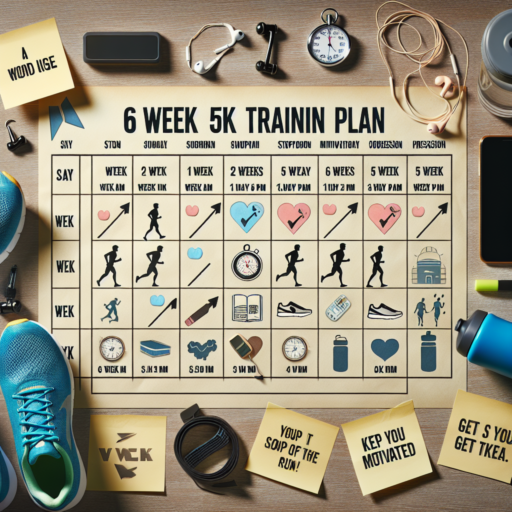Introduction to Your 12-Week 5K Training Plan
Welcome to your tailored 12-Week 5K Training Plan, the perfect guide for anyone looking to conquer a 5K race, whether you’re a beginner runner or someone who wants to improve their time. This comprehensive approach to running a 5K ensures that you’ll not only cross the finish line but you’ll do so with confidence and improved fitness. The journey towards a successful 5K run requires dedication, consistency, and the right mindset, and this plan is designed to build exactly that.
The core of our 12-Week 5K Training Plan revolves around gradually increasing your running stamina, enhancing your speed and building your running confidence week by week. Starting slow, we focus on getting you comfortably running, making sure we avoid any injuries and burnouts. By breaking down your training into manageable tasks, we ensure that you’ll steadily progress without feeling overwhelmed. This methodical approach not only prepares your body for the increasing demands of running a 5K but also gets your mind in tune with your body’s growing capabilities and resilience.
Throughout your training, you’ll engage in varied workouts, rest days, and cross-training sessions to keep your routine balanced and interesting. Each component of the training plan is essential in developing the different facets of your running ability, from endurance to speed, and even your mental tenacity. Remember, the key to a successful 5K run is not just about how fast you can go but also about enjoying the journey, setting realistic goals, and embracing the challenge with a positive spirit.
Weeks 1-4: Building the Base for Your 5K Success
The initial four weeks of your training plan for a 5K run are foundational, paving the path towards achieving your goal. This period is all about creating a solid base—a crucial phase that should not be underestimated. Establishing this base is vital for enhancing your running efficiency, building endurance, and reducing the risk of injury. It’s a time to gradually increase your mileage and introduce variety into your workouts to prepare your body for the more intense training that follows.
During these initial weeks, focus on consistency and patience. You’ll start with shorter, manageable runs to accustom your body to the new demands you’re placing on it. It’s also the perfect time to incorporate cross-training activities, such as cycling or swimming, which can improve your aerobic capacity while giving your running muscles a much-needed break. Remember, the goal of this phase is to build up gradually, avoiding the temptation to do too much too soon, which can lead to setbacks.
Another crucial element in these first weeks is developing good running habits. This includes focusing on your running form, practicing regular stretching, and ensuring you have the right footwear. Paying attention to how you run can make a significant difference in your training and help in preventing injuries. Similarly, dedicating time to post-run recovery strategies and proper nutrition will support your body as it adapts to the increased physical activity. This foundational period is as much about building physical endurance as it is about cultivating the mental resilience and habits that will carry you through to your 5K success.
Weeks 5-8: Increasing Distance and Enhancing Endurance
As you enter into the second phase of your training, Weeks 5-8, it’s time to elevate your running regimen. This period is crucial for increasing distance and enhancing endurance, building on the foundation you’ve laid in the initial weeks. During this phase, your focus shifts towards pushing your limits gently, ensuring that you improve steadily without risking injury.
To effectively increase your running distance, it’s recommended to follow the 10% rule, where you increase your weekly mileage by no more than 10% from the previous week. This gradual upscaling allows your body to adapt to the increasing demands without overwhelming it. Alongside distance, enhancing endurance is paramount. Incorporating longer runs into your schedule, once a week, helps acclimate your body to sustained periods of exertion, improving your cardiovascular system’s efficiency.
Remember, recovery is key during this phase. The importance of rest days and active recovery sessions cannot be overstressed. These elements are essential in preventing injuries and ensuring your body has ample time to recover and strengthen. Incorporate low-impact cross-training activities like cycling or swimming on rest days to maintain fitness levels without straining your running muscles. Proper nutrition and hydration also play a crucial role in supporting your enhanced training efforts during these weeks, fueling your runs, and aiding in recovery.
Weeks 9-12: Speed Training and Tapering Before the Race
As we enter the final stretch of our marathon training program, weeks 9-12 switch focus towards Speed Training and Tapering before the race. This crucial phase is designed to fine-tune your performance and ensure you’re at your peak on race day. During these weeks, the intensity of your training will shift, with an emphasis on maintaining your fitness while reducing overall volume to prevent fatigue and overtraining.
Speed Training in this period encompasses specific workouts aimed at increasing your running economy and VO2 max. Sessions include interval runs, where you’ll alternate between high-intensity sprints and recovery periods, and tempo runs, designed to improve your lactate threshold. These workouts are critical for enhancing your ability to sustain a faster pace over the marathon distance.
Meanwhile, Tapering begins after the last long run of your training cycle. Typically starting 2-3 weeks before the race, tapering involves gradually decreasing the volume of your runs to allow your body to recover fully and store energy for race day. This phase requires a delicate balance; reducing training too much can lead to a loss of fitness, while tapering too little might not allow your body enough rest. The key is to maintain some element of speed work to keep your legs feeling sharp, while significantly cutting back on mileage.
No se han encontrado productos.
Nutrition Tips for 5K Training
Preparing for a 5K involves not just regular running and workouts but also adhering to a nutritional plan that supports your body’s needs. The right diet can significantly impact your training performance and recovery times. Focusing on certain key nutritional strategies can help optimize your 5K training experience and ensure you’re fueling your body correctly.
1. Emphasize Carbohydrates
Carbohydrates are critical for runners as they provide the primary source of energy during high-intensity workouts. Incorporating a variety of whole grains, fruits, and vegetables in your diet ensures a steady energy release. Before a training session, consider meals or snacks that are rich in carbs yet easy on the stomach to maximize your performance without discomfort.
2. Stay Hydrated
Hydration plays a pivotal role in optimal performance and recovery. Drinking adequate water throughout the day, especially before, during, and after your training sessions, helps to prevent dehydration. For longer or more intense runs, you might also consider electrolyte-enhanced drinks to replenish the salts lost through sweat and maintain electrolyte balance.
3. Prioritize Protein Intake
Protein is essential for muscle repair and growth, making it a vital component of any runner’s diet. Aim to include a good source of protein in every meal and snack. Foods such as lean meats, beans, lentils, and dairy products are excellent choices that provide the necessary amino acids for muscle recovery. Pairing protein with carbohydrates can also enhance muscle glycogen replenishment, crucial for your next training session.
Injury Prevention Strategies During Your Training
Ensuring the implementation of injury prevention strategies during training is crucial for athletes at all levels. These strategies aim to minimize the risk of injuries that can sideline athletes from their training routines and competitions. By understanding and applying certain key guidelines, individuals can protect themselves more effectively against common training-related injuries.
Warm-Up and Cool-Down Techniques
One of the fundamental components of injury prevention is incorporating thorough warm-up and cool-down sessions before and after training, respectively. A proper warm-up increases body temperature and blood flow to the muscles, preparing them for the stress of exercise. Conversely, cooling down helps in the gradual recovery of heart rate and blood pressure, along with the reduction of muscle stiffness.
Proper Training Techniques and Progressions
Another vital aspect of preventing injuries lies in adopting proper training techniques and ensuring gradual progression in intensity and volume. This approach helps in avoiding the common pitfall of overuse injuries, which occur due to repetitive strain without adequate recovery. Learning correct form and technique from professional coaches or trainers can drastically reduce the risk of injury and enhance overall athletic performance.
Ultimately, injury prevention strategies serve not only to protect athletes but also to optimize their training outcomes. By emphasizing warm-up and cool-down routines, correct techniques, and careful progression, individuals can maintain a consistent training schedule free from the interruptions caused by injuries.
Essential Gear for Your 5K Training Journey
Embarking on a training journey for a 5K run presents a mixture of excitement and determination. Equipping yourself with the essential gear is not just about enhancing your training experience; it’s about maximizing performance, ensuring safety, and keeping motivation levels high. Every piece of gear serves a purpose, from providing comfort to boosting your efficiency during those critical training sessions.
Running Shoes: Perhaps the most crucial element in any runner’s arsenal, the right pair of running shoes can make a difference. Tailored to withstand repetitive impact while providing ample support and cushioning, a perfect pair plays a pivotal role in preventing injuries. It’s not merely about the aesthetics; it’s about finding a shoe that complements your foot’s arch, stride, and the surface you’re running on. Research and professional fitting are key steps in selecting the right shoe for your 5K training journey.
Technical Clothing: Another key piece of gear for any 5K aspirant includes technical clothing designed to keep you comfortable, regardless of the weather conditions. Clothing that wicks moisture away from your body and allows for optimal breathability can significantly impact your training. From lightweight, breathable fabrics for those hot summer days to insulated, waterproof layers for cold, wet sessions, the right clothing helps maintain body temperature, reduces chafing, and keeps you focused on your running goals.
Understanding and selecting the essential gear for your 5K training journey is not just about preparation; it’s about investing in your comfort, performance, and overall training success. Whether it’s the perfect pair of running shoes, the most efficient technical clothing, or other gear specifics like hydration solutions and injury-prevention tools, each plays a vital role in your training regimen. Remember, the correct gear can be the difference between an enjoyable training experience and an unbearable one.
Mental Preparation Techniques for Race Day
Preparing mentally for race day is as pivotal as the physical training that precedes it. A strong mental state can significantly influence performance, helping athletes to manage stress, maintain focus, and harness their full potential. Understanding and implementing mental preparation techniques can make all the difference when it comes to reaching the finish line not just in time, but with confidence.
Visualization Techniques
One of the most powerful mental preparation methods is visualization. By mentally simulating the race, athletes can condition their minds for success. This involves picturing yourself succeeding in your race, imagining overcoming difficult sections, and feeling the sensations of crossing the finish line victoriously. Visualization not only prepares the mind for what is to come but also instills a deep-seated belief in one’s abilities to perform under pressure.
Routine and Relaxation Practices
Establishing a pre-race routine and practicing relaxation techniques are also crucial for mental preparation. A set routine before the race, including visualization, light physical warm-ups, and mental exercises like meditation or breathing techniques, can ease nervousness and set a positive tone for the day. Relaxation practices such as deep breathing or progressive muscle relaxation help in managing race-day anxiety, keeping both the mind and body in a state conducive to optimal performance.
Understanding the Importance of Rest Days
When we talk about optimizing fitness and health, the role of rest days cannot be overstated. These are the days specifically set aside from rigorous exercise or training routines, allowing the body to recover, repair, and strengthen. It’s a common misconception that more exercise will automatically lead to better results. However, without proper rest, the body can actually move in the opposite direction, towards fatigue or injury rather than improved strength and endurance.
Rest days are critical for preventing overuse injuries, a common issue among athletes and fitness enthusiasts. These injuries result from repetitive strain without adequate recovery periods. By incorporating rest days into an exercise regimen, individuals give their muscles, joints, and tendons the necessary time to recover from the stress of physical activity. This approach not only prevents injuries but also contributes to improved performance in the long run.
The Psychological Benefits of Rest Days
Aside from the physical benefits, rest days offer significant psychological advantages. They provide an essential break from the mental and emotional strain that often accompanies intense training schedules. This mental break can help prevent burnout and maintain motivation, making it easier for individuals to stick with their fitness goals over time. Moreover, rest days can be an opportunity to reflect on progress, set new goals, and engage in activities outside of the usual fitness routine, contributing to a more balanced and enjoyable lifestyle.
Cross-Training Activities to Boost Your 5K Performance
Engaging in cross-training activities is crucial for runners looking to enhance their 5K performance. Incorporating diverse forms of exercise not only prevents boredom but also reduces the risk of injury by balancing muscle use. Below are endorsed cross-training activities that can significantly aid in improving your 5K run times.
Strength Training
Strength training is pivotal for runners aiming to boost their 5K performance. Exercises focusing on the core, legs, and glutes can greatly enhance running efficiency and speed. Incorporating weightlifting sessions two to three times a week can lead to substantial improvements, including better endurance and reduced fatigue during runs.
Swimming
Swimming is a perfect low-impact cross-training activity that emphasizes cardiovascular fitness while giving the joints a much-needed break from the wear and tear of running. It fosters endurance and muscle strength across multiple core and lower body muscles, essential for a robust 5K performance. Integrating swimming sessions into your weekly training routine can result in enhanced breathing techniques and overall stamina.
Yoga
Yoga is not just for relaxation and flexibility; it’s a powerful tool for runners. By improving flexibility, balance, and core strength, yoga provides runners with the stability needed for efficient running mechanics. Weekly yoga sessions can aid in preventing injuries by increasing muscle elasticity and joint mobility, vital for enduring the rigorous demands of 5K training.




